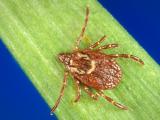Apr 8, 2003 (CIDRAP News) – A study focusing on the two plasmids, or extrachromosomal DNA rings, usually found in Bacillus anthracis cells helps explain why different varieties of anthrax differ significantly in virulence.
It has generally been assumed that each anthrax cell has only one copy of each plasmid, but the new research shows that cells carry multiple copies and that the number of copies varies widely, according to the report in the Journal of Clinical Microbiology. Further, the study suggests that the virulence of a given anthrax variety depends to some extent on the number of copies of one of the plasmids, called pXO2.
"We have shown that the number of pXO2 plasmids in each bacterial cell contributes to the level of virulence associated with that isolate," states the report by Pamala R.Coker and five colleagues. The authors are from Louisiana State University, Lawrence Livermore National Laboratory in California, and the US Army Medical Research Institute of Infectious Diseases in Maryland.
Plasmid pXO2 carries genes that enable B anthracis to shield itself in a capsule that helps repel the immune system of host organisms. The other plasmid, pXO1, permits anthrax to make three proteins that function together as a toxin that invades and destroys host organism cells. Anthrax strains that lack either plasmid are either nonvirulent or significantly weakened, according to the report.
The researchers inoculated groups of guinea pigs with the standard anthrax vaccine (anthrax vaccine adsorbed) and then exposed them to 20 different B anthracis strains representing the full range of anthrax genotypes. The strains were from seven different genotypic groups, called MLVA clusters, defined in previous research. The number of plasmid copies for each strain was determined by using quantiative polymerase chain reaction (QPCR), a PCR method developed for rapid detection of B anthracis in environmental samples. The investigators examined the guinea pigs' survival rates in relation to the genotypic clusters and the ratio of plasmid copies to chromosomes.
The QPCR analysis showed that the number of plasmid copies per cell varied from 33 to 243 for pXO1 and from 1 to 32 for pXO2. The authors found that the genotypic cluster and the radio of pXO2 copies to chromosomal material both were significant predictors of guinea pig mortality, but the ratio of pXO1 copies to chromosomes was not.
Within each genotypic group, a higher ratio of pXO2 copies to chromosomes was linked with a lower survival rate, the authors found. However, results also showed that the genotypic cluster had "a much greater influence on survival outcome" than the number of plasmid copies did. For example, one anthrax strain with a pXO2/chromosme ratio of 1.5 was linked with 0% survival, while a strain from a different genotypic group had a pXO2/chromosome ratio of 1.6 but was associated with 94% survival.
The reason for the association of higher or lower levels of virulence with specific genotypic clusters is unknown, but "the relationship is plausible from the standpoint of mutations and clonality," the report says. A similar association has been seen in other pathogens, such as Francisella tularensis, the cause of tularemia, the authors note.
The investigators used their findings to develop a model to predict anthrax virulence on the basis of plasmid copy numbers and genotypic groups. The model was tested by comparing the predicted and actual survival of guinea pigs exposed to 12 randomly chosen anthrax strains, and the results validated the model, according to the report.
Although the study showed no effect of pXO1 copy numbers on anthrax virulence, the authors suggest that a test involving exposure of unvaccinated animals to anthrax would probably reveal such an effect. They call for research on unvaccinated animals to further test their model, which they say could prove useful in testing anthrax vaccines.
Coker PR, Smith KL, Fellows PR, et al. Bacillus anthracis virulence in guinea pigs vaccinated with anthrax vaccine adsorbed is linked to plasmid quantities and clonality. J Clin Microbiol 2003;41(3):1212-8 (Abstract)




















